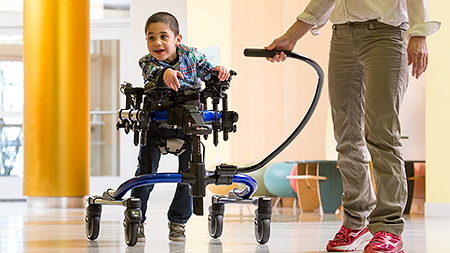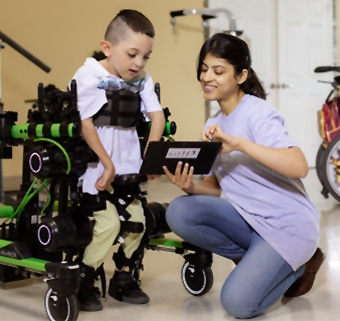Weight-bearing Assistance and Pelvic Positioning with the New Pacer Gait Trainer
| June 2017Rifton’s new Pacer gait trainer has three options for weight-bearing assistance and positioning of the hip girdle:
1. the multi-positioning saddle
2. the hip positioner, and
3. the pelvic support
Here’s a brief description of each with our recommendations to help you choose the right one for your clients.
 Multi-Positioning Saddle
Multi-Positioning Saddle
The multi-positioning saddle (MPS), named for its five adjustment possibilities, provides a unique opportunity to control pelvic positioning and alignment in relation to the shoulder girdle and lower extremities. MPS adjustments include saddle height, saddle depth (anterior and posterior positioning), saddle angle (forward tilt and backwards tilt), hip corral height and hip corral depth.
We think the MPS works best with the dynamic upper frame of the new Pacer gait trainer. Because it  attaches to the upper frame, the MPS transfers the dynamic movement to the pelvis while still maintaining a well-positioned pelvis in the saddle. This is useful for postural alignment during gait, facilitating weight shifting and step taking and for some, absorbing excessive spastic movements.
attaches to the upper frame, the MPS transfers the dynamic movement to the pelvis while still maintaining a well-positioned pelvis in the saddle. This is useful for postural alignment during gait, facilitating weight shifting and step taking and for some, absorbing excessive spastic movements.
Easier Transfers: For heavier clients, transfers with the MPS are generally easier and safer. By lowering the upper frame and MPS to align with the seating surface you can ease the clients onto the saddle. Caregivers then raise the client into an upright position for gait training by lifting the upper frame, supported by the gas-assist column.
Abduction Opportunity: the firm padded cushion of the MPS has the added benefit of an abduction prompt for moderate leg separation. In many cases, the padded arm underneath the seat cushion provides adequate abduction so that use of thigh prompts is not necessary.
Posterior Positioning: Quickly switch the MPS around to use the gait trainer in the reverse position.
Consider selecting the MPS for these clients:
- Larger, heavier clients with minimal weight-bearing ability, where transfer is difficult.
- Clients with significant postural challenges including ataxia or spasticity.
- Clients who display scissoring of the legs when walking but do not respond well to use of the thigh prompts or ankle prompts
 Hip Positioner and Pad
Hip Positioner and Pad
The hip positioner swings with a client’s walking motion, allowing the user to shift weight from one leg to the other. A pad adds extra comfort for clients who rely on its weight-bearing assistance feature. The four straps allow free movement of the hips in multiple planes- great for challenging and developing motor control of the hip girdle during gait. For increased challenge and movement during gait, use this accessory together with  the dynamic upper frame.
the dynamic upper frame.
The front straps buckle anywhere along the top bar or around any of the accessory posts, providing opportunity to optimally position the pelvis in relation to the shoulder girdle and lower extremities. The rings on the posterior straps of the hip positioner clip onto the handholds (also moveable on the top bar of the frame). These rings unclip for transfers into the device.
Consider selecting the hip positioner and pad for these clients:
- Clients with moderate weight-bearing ability, able to partially assist their own transfer into device.
- Clients needing comfortable weight bearing assistance over longer distances.
- Clients with sufficient motor control of their hip girdle but needing further challenge in postural control and development.
- Clients who require thigh prompts. (Thigh prompts were originally designed for use with hip positioner and pad.)
 Pelvic Support
Pelvic Support
The pelvic support is a softer, more flexible alternative to the hip positioner, with less bulk between the legs. Like the hip positioner, the pelvic support provides weight-bearing support as needed while clients build strength and stamina.
The front straps buckle anywhere along the top bar or around any of the accessory posts for optimal positioning. Due to the soft, pliable nature of the fabric we recommend attaching the front straps as close to the client’s hips as possible for a better fit and more support.
 The rings on the posterior straps of the hip positioner clip onto the handholds mounted on the Pacer frame. We recommend pointing the handholds forward or inward, to achieve a sling-like fit with the posterior part of the support for the client’s buttocks. Additionally, the ring clips on the posterior straps enable a quick and secure transfer for a client with partial weight-bearing ability.
The rings on the posterior straps of the hip positioner clip onto the handholds mounted on the Pacer frame. We recommend pointing the handholds forward or inward, to achieve a sling-like fit with the posterior part of the support for the client’s buttocks. Additionally, the ring clips on the posterior straps enable a quick and secure transfer for a client with partial weight-bearing ability.
As with the hip positioner, the four straps allow free movement of the hips in multiple planes for the development of motor control of the hip girdle during gait. For increased challenge and movement during gait, use this accessory together with the dynamic upper frame.
Fall Arrest Harness: Simply lengthen the straps of the pelvic support so it hangs freely under the client and acts solely as a safety sling for those clients who are almost fully weight-bearing.
Consider selecting the pelvic support for these clients:
- Clients with moderate weight-bearing ability, able to partially assist their own transfer into device.
- Clients who find the hip positioner too bulky between the thighs or those who do not need the abduction feature of the MPS.
- For those clients who have developed adequate motor control of their hip girdle and improved weight bearing and only require a safety sling.
- Your smallest clients who will benefit from the support’s slim cut.
- Clients who require thigh prompts. (Thigh prompts were originally designed for use with hip positioner and pad.)




